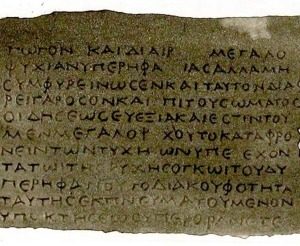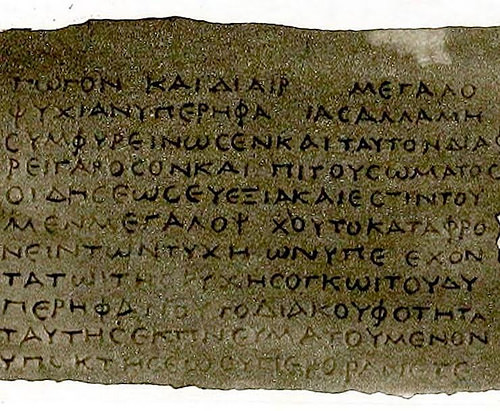
Analysis of Herculaneum papyrus scroll fragments reveals the use of metallic ink in Greco-Roman literary inscription centuries earlier than previously thought, according to a study*. Scholars of ancient scrolls hold that texts from antiquity, particularly Greek and Latin literary manuscripts produced until the fourth century AD, were largely written in carbon-based ink on papyri, the fibrous structure of which allowed scribes to jettison ruling lines. Vito Mocella and colleagues used nondestructive synchrotron X-ray-based methods to chemically analyze the barely visible black inscriptions on two nearly flat, multilayered papyrus fragments that were found at the Villa dei Papiri at Herculaneum in the mid-18th century and are housed at the Paris-based Institut de France. The introduction of metal in writing materials is generally dated to fourth-fifth century AD, but the fragments’ high lead concentrations—around 84 µg/cm2 and 16 µg/cm2—suggest purposeful use of lead-containing ink, thus ruling out contamination from aqueducts, inkpots, or containers, and pushing back by several centuries the advent of metallic ink for literary inscription in the Greco-Roman period. Spots of concentrated lead likely correspond to the beginnings and ends of the scribes’ pen strokes on the scrolls. Letters on the fragments were bounded by naturally occurring horizontal lines of papyrus fibres that appear to have served as alignment guides for straight-line writing. The lines are likely signatures of cristobalite, a quartz-like mineral found in the papyrus plant. According to the authors, the findings might shape future analysis of unopened Herculaneum scrolls.
_______________________________________
An example of a section of one of the charred/carbonized scrolls found at the Villa dei Papiri in Herculaneum. Wikimedia Commons
____________________________________________________
The Herculaneum papyri consist of more than 1,800 papyri found in Herculaneum in the 18th century, carbonized by the eruption of Mount Vesuvius in AD 79.
Source: PNAS subject news release
____________________________________________________
* “Revealing metallic ink in Herculaneum papyri,” by Emmanuel Brun et al.
____________________________________________________

______________________________________________
Travel and learn with Far Horizons.
____________________________________________
This richly illustrated issue includes the following stories: Recent findings shedding new light on the whereabouts of the remains of Philip of Macedon, father of Alexander the Great; how an archaeologist-sculptor is bringing bones of the dead back to life; archaeologists uncovering town life at the dawn of civilization; an exclusive interview with internationally acclaimed archaeologist James M. Adovasio about what makes the Meadowcroft Rockshelter prominent in the ongoing search for the first Americans; what archaeologists are finding at the site of the ancient city of Gath, the home town of the biblical Philistine giant, Goliath; and how scientists are redrawing the picture of human evolution in Europe. Find it on Amazon.com.









